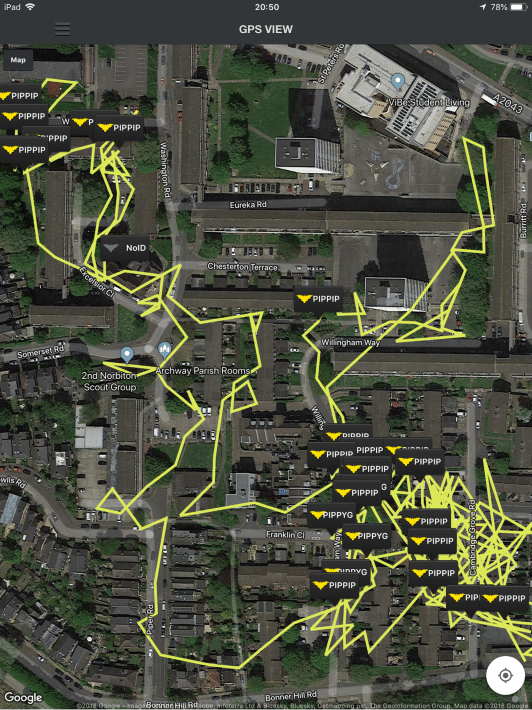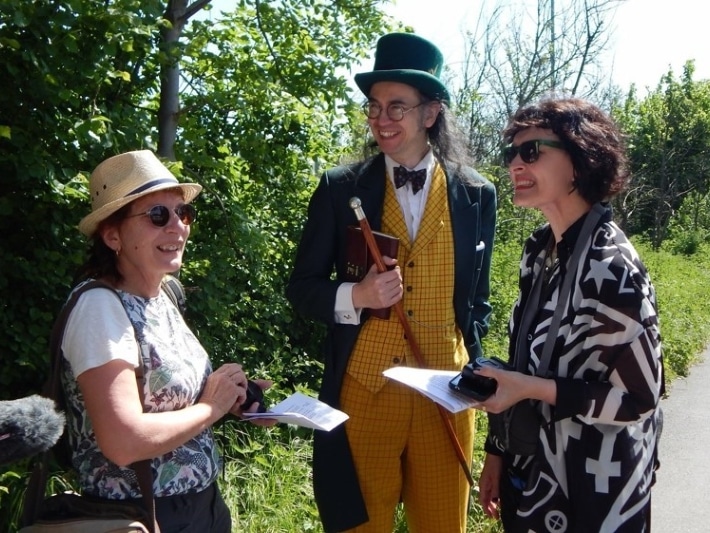Alison Fure
Alison has been providing her records, both personal and professional, to GiGL for many years, and has encouraged others to do so too. In January 2018 we calculated that Alison was the fourth main provider of records for the Royal Borough of Kingston upon Thames, preceded only by the London Natural History Society, Greater London Authority and The Royal Parks.
After false starts, and to echoes of the Specials ‘Ghost Town’, I went to the Netherlands in 1980 to find work; there was no work here, especially for a holder of a sociology degree. I became a gardener in Haarlem, growing bulbs for Wisley and Kew Gardens, then on my return to the UK I began my own gardening business, now run by my son (with some of the same customers).

Photo-plot of survey data on a high-density estate in Kingston. Ppips = common pipistrelle bats and Ppyg’s = soprano’s.
After joining the Surbiton Bird Club, I began professionally undertaking common bird census surveys. This took off after achieving an MSc in Ecological Management and Monitoring at Roehampton and I would now describe myself as an urban field ecologist, informing clients about the wildlife interest on their landholdings.
This pivots on my interest in bats and the urban gradient, especially in relation to light pollution. The photo-plot opposite is an example of a high-density estate in Kingston, which has retained landscape features of bat interest.
My client base is a 60-40% split between community groups and institutions, including around 18 of the London Boroughs. One particularly memorable job was assisting the London Borough of Redbridge in introducing local people to their open spaces. We had a Halloween event – a bat walk after which we were beckoned by magical elves to follow them to where we watched incredible fire spinners.
I record everything: from sewage spills, to every possible way of recording small mammals, especially bats. My favourite methods are camera traps, static bat detection equipment and a dormouse box scheme in North Surrey. I also count and save every type of poo. I disseminate the information using the software Mapmate for records but also blog the information on Wildlife Circus: https://alisonfure.blogspot.com/. I additionally give talks and lead walks.
With the London Bat Group, I have led harp trapping teams for the National Nathusius’ Pipistrelle project at south-west London sites. We have discovered non-target species including brown long-eared bat, whiskered and Brandt’s bat. As part of the Richmond Bat Species Action Group I have assisted in producing a leaflet on light pollution which can be adapted to other river corridors.
As a director of Kingston Biodiversity Network, I lead different types of walks. They could be a wassailing event or a walk personifying important characters, such as Alexander Mitchelson who founded a Kingston heritage apple, which you can read more about here. We have new orchards planned for the borough as well as an apple heritage trail leaflet.
This year, with local poet and writer Lucy Furlong, we led a popular series of walks known as Tolworth Treasure and the Hogsmill Hum. In the case of the Richard Jefferies walk – recorded by Radio 4 for a series on Walking Women (listen online here) – a friend plays the part of Richard Jefferies, as seen in the photo below. He lived in Tolworth in 1877 and wrote Nature Near London giving us baseline information of 2,000 lapwing he recorded on Tolworth Court Farm and the trout he saw in the Hogsmill river.
Next year I am working on a website for a similar event, so watch this space.

The Richard Jefferies Walk (c) P. Atkinson
